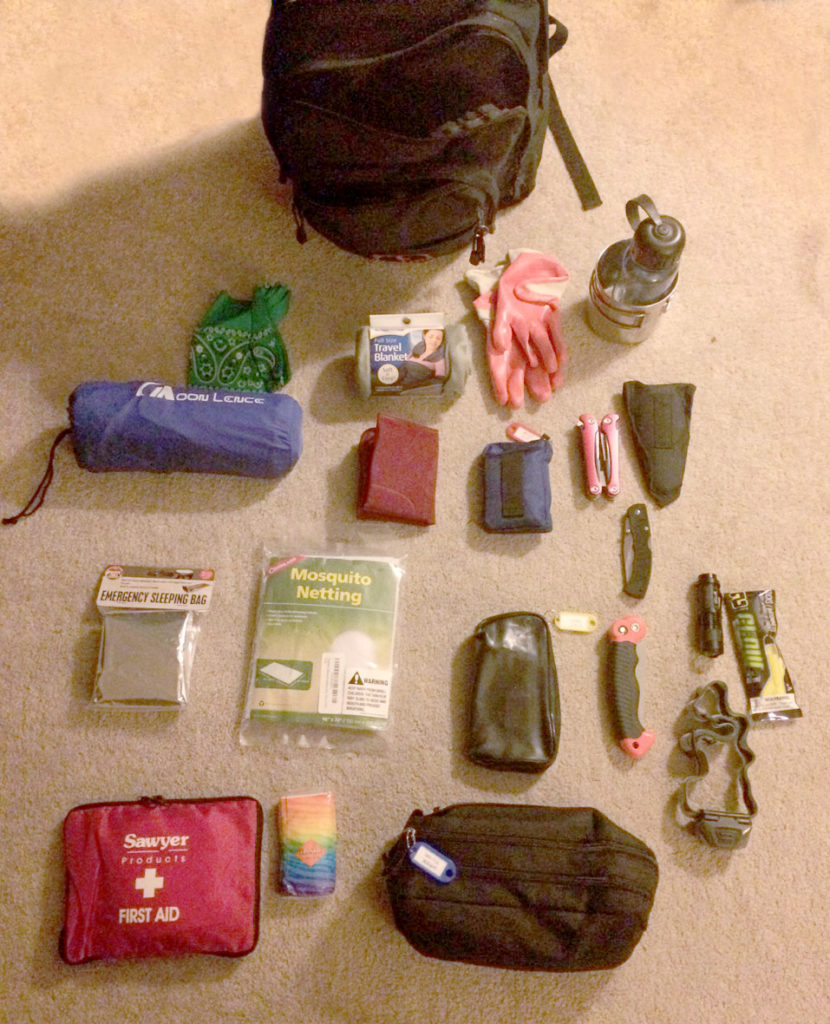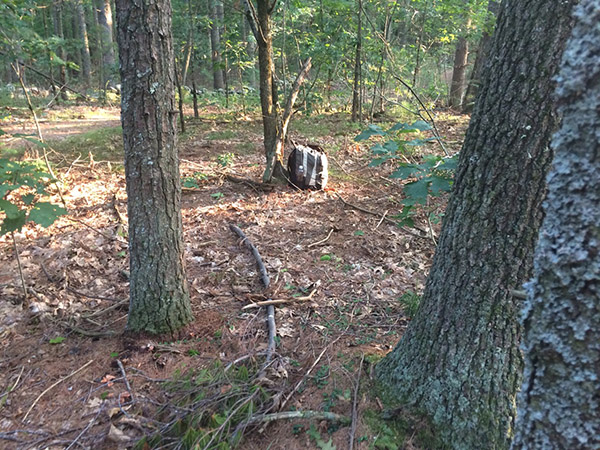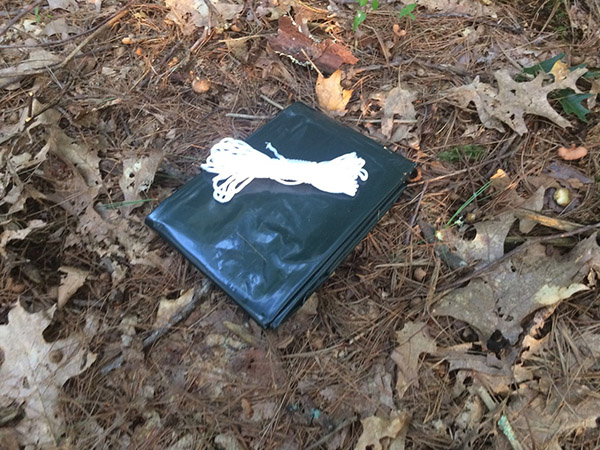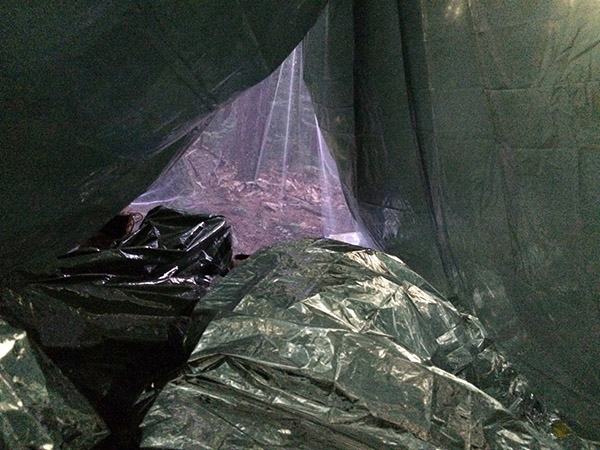This third test of our Bug Out Bags focused on minimalism. What if we were bugging out on foot on a multi-day trek? Having our bags as light as practical would be important. Minimalist gear is lighter but how does it fare in actual overnight camping?

Your Mileage May Vary
What qualifies as “minimal” will vary from person to person. At one end of the spectrum: a knife and a loincloth. At the other end of the spectrum are people for whom an RV is ‘roughing it.’ In between is a wide gray area. You may very well have a leaner version of minimal than we did. Go for it.
Scenario 3.0
This exercise imagined that we were trying to travel on foot for three or four days to reach our safe destination and future supplies. As such, as light of a bag as possible/practical was important to keep our pace up. Camps for overnights would need to be quick to set up and take down in order to maximize travel time.
BOB Lite
We started with our existing Go Bag load-outs and looked for gear not strictly necessary for quick, multi-day travel. We looked for bulk and weight that we could mitigate with some smaller/lighter gear. For instance, I would leave home my trusty 21” Sven Saw. We would not be constructing debris huts or cutting all-night firewood. We kept the 9” folding saw my wife’s bag usually carries as a just-in-case. I would leave home my folding shovel in favor of the folding trowel from my wife’s bag. Our goal was a quick overnight and gone, not cozy base camps.
To cut down on weight AND bulk, we opted to try an “emergency” plastic tube tent. (11 oz. vs. 6 lbs. for the pop-up tent) We opted for “emergency” bivvy sleeping gear instead of our usual sleeping bags. I used the Tact Bivvy and my wife used one of those mylar products. This saved on both a weight and bulk.
My Bag’s Contents
Pictured below are the contents of my Go Bag. Without getting into tedious labeling, (as some things are obvious enough), there are snack bars in the bag at

My Wife’s Bag
In addition to the customary items, she has the black/orange folding saw and the folding trowel. Her ‘emergency sleeping bag’ is on the far left between her blue inflatable pad and the red first aid kit. She has a duplicate Sawyer Mini and fire kit.

Design Goals
As stated in the intro, the scenario for this test was that we were trying to travel three or four days — on foot — to some remote safe location. We were not going “INCH” (I’m Never Coming Home) so we did not need to carry a kitchen sink. We were not planning to stay in any one place long enough to hunt or fish. The goal was to get from A to B as quickly as two non-twenty-year-old, non-Army-Rangers could manage.
Fast Food
Since our goal was speed on foot, we opted for lightweight dehydrated “hiker” meals that could be prepared with a little boiling water. MREs are handy but heavy. We opted for instant oatmeal packets for breakfast. Again, light and easy to make. The nights in late summer up in New Hampshire get a little cool (low 40s) so a hot meal and a hot breakfast were favored over an all-cold menu — which would be perfectly viable. We just liked hot meals. For lunches, we had granola bars that could be eaten while walking.
Site Selection
Trek

I found a spot that was relatively level and required only a little clean-up of sticks and rocks. There weren’t two ideal trees to tied the ridge line to, so I improvised with some paracord strung between two trees for the entrance side. It worked.
The Tube Tent
Setting up the tube tent went pretty quickly. Run the ridge line through the tube and tie it to both trees. It was up in a few minutes. I found four rocks to place in the corners to hold the triangle shape. Since there were still plenty of mosquitoes out, we laid up mosquito netting at both open ends. All told, the tube tent went up just a little bit less time than the pop-up tent requires. Yes, sleeping under the stars would be faster. We set up as if it were going to rain that night (which it didn’t).

The tent is (basically) trash bag plastic. It is not the heavy-duty trash bag plastic but it seemed to resist pokes from sticks on the ground, etc. It held up okay. The color of green is pretty good for concealment. It is not camo, but it also not a bright color. If you want better concealment, a bit of leafy debris would do the trick.

From the inside looking out, the plastic is somewhat translucent. This was okay, as it gave some sense of the surroundings without being actually transparent.
Making Water

Traveling fast and light assumed we would come across wild water. The stream (maybe 200 yards from the campsite) was running. I used my handy folding silicone cup to pour water into the Sawyer’s supply bag. Squeezing the supply bag did not seem to make the water go through the filter all that much faster. I set up an ad hoc drip system once I had enough to boil for supper. A slow-but-steady drip filtering was a lot less work. I filtered more than enough for supper, coffee and breakfast on the assumption that we might not find water as handily the next day.

Mini Rocket Stove
Scanning the vicinity for rocks, I found a nice flat one that could serve as a hearth. The same little tin-can stove from Gear Test 2 got the water for supper boiling in about ten minutes. The twigs seemed damp (heavy dew season) so I used a TinderQuick from my fire kit (kept dry in an old pill bottle). Yes, I could have used my ferrocerium rod, but the little Bic lighter was faster. Supper of a 2-serving Mountain House meal was very satisfying as the cool and damp of the evening settled in.

Mini Bivvy Plan
Both my wife’s “emergency sleeping bag” (a mylar pocket) and my Tact Bivvy tout how they reflect 90% of your body heat back to you. Aside from the crinkling noises they make whenever you move, they were sufficient to keep off the evening chill. We had sweatshirts with hoods for our heads.

The drawback to the mylar bivvy idea is that they don’t vent moisture. You continue to perspire as you sleep. At first, that did not matter. In the early wee hours, cool night air meant the mylar pockets condensed dew on the inside. Staying dressed and in a hoodie helped prevent
The Howling
In the pre-dawn hours, the colony of coyotes that (they say) live on an island in the swamp to the east, began howling. One would start yipping and that would set off several of them yowling together rapidly. Then, they would all fall silent for a few minutes before another of them would yip and set it off again. These were the same coyotes that killed several of the pastor’s chickens and decimated his neighbor’s flock of ducks. Heightened awareness of sounds nearby made it near impossible to go back to sleep.
Breakfast and Breaking Camp
What with being awakened early by the coyotes, it was easy to get up and get the fire going before the sun rose. Bringing some of the kindling sticks into the tent and placing them in an unused plastic package saved them from being soaked with dew — which everything else was. The little hobo stove boiled the water but it seemed to need extra attention to keep the fire going well. (damp wood) Even instant coffee tasted great on a cool, damp morning. Sipping hot coffee eased the wait for the second boil for the oatmeal.

While waiting for the oatmeal water to boil, we broke camp. We turned the “sleeping bags” inside out and hung them on a line to dry. The tent came down quickly, since I used quick-release knots. The collapsed tent served as a handy (and clean) roll-up, fold-up surface. By the time the oatmeal was ready to eat, we had everything repacked except the sleeping bags and the stove. The sleeping bags needed a wipe down with a bandana to speed the drying.
We buried the ash and char in a little hole dug with the folding trowel. Everything was back in the bags and on our backs before the sun lit up the treetops. We had a half gallon or so of filtered water to start what would be our second day. When we left, the site looked like no one had ever been there.
Successes
The tube tent — This was actually better than expected. It was big enough to sit up in (in the middle) and wide enough for two to sleep side by side without touching the tent sides. The plastic looked flimsy but was durable enough if you were careful not to abuse it. The tube tent was clearly good for multiple nights. At roughly 8 x 10 inches (folded) and 10 oz., it packed easily.
While the night was not Hilton Comfort, we got some rest, were protected from the weather and ready to go again in fairly short order. That met our design goal.
Lessons Learned
Mylar “emergency sleeping bags” — They are better than nothing but not great. If the elements are cool enough that you need to reflect 90% of your body heat, it will be cool enough to make dew on the inside of the bag. Your clothes (and you’ll have to sleep clothed) will be damp or wet from where you contacted the mylar and your own dew. (knees, elbows, toes, etc.) My next gear purchase will be for a “breathable” bivvy sack like the SOL Escape Bivvy. They’re a bit bulkier, heavier, and more expensive. Still, less bulk than a regular sleeping bag. Fine for milder weather.
Sawyer Mini Drip — The squeezing of the supply water bag takes time and effort. The time spent on the water was not in keeping with the goal. I couldn’t do anything else while squeezing that bag. While the gravity-feed drip method was not fast, I can do other things while it dripped. Plan on overlapping multi-tasking.
Dip Cup — The collapsable silicone cup for dipping in the stream worked great. Wild water will always be down low (unless you find a waterfall), so a way to bring it up to your supply bag is nice.
Gray Bonus — Our minimal gear meant that only our conventional backpacks were visible to others as we walked: no sleeping bags or tents, etc. to announce, “They’re going to stop and camp,” or “They’ve got Stuff!” We could also travel less encumbered by bulk and not look as obviously like migrants.
Confidence Building — Experiencing some minimalist camping was good for reassuring us that we did not need a lot of bulky gear.
What is your idea of minimalist camping? Have you tried your gear out that way?
